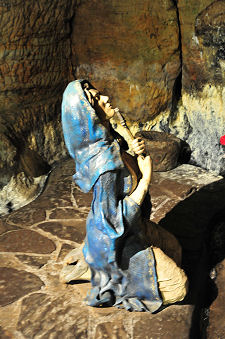 St Margaret's Chapel, Edinburgh Castle |
Saint Margaret of Scotland lived from 1045 to 16 November 1093. She was probably born in what is now Hungary, and her grandfather on her mother's side was thought to have been Yaroslav I the Wise, Prince of Novgorod and Kiev. The wider picture in Scotland at the time is set out in our Historical Timeline.
Margaret's great-uncle was King Edward the Confessor of England. When King Harold was killed by the Normans at the Battle of Hastings in 1066, Margaret's brother Edgar Atheling was regarded by the English as rightful heir to the throne. This was not accepted by William of Normandy, and together with their mother, Edgar and Margaret sailed from Northumberland to exile on the continent. A storm took them instead to Scotland, where they were given refuge by Malcolm III, who probably already knew them well from his own years of refuge in England, when Macbeth was on the Scottish throne.
Malcolm III was a widower with three children from his first marriage when he and Margaret married in 1070. Margaret's impact was dramatic. She favoured the Roman Catholic church to the Celtic Church and brought Benedictine monks to establish an abbey at Dunfermline. To allow her to feel more at home, Malcolm decreed that the language used at court should be Saxon rather than Gaelic. As a result Malcolm III was the first to be called "King of Scotland" in his own time.
Margaret also had built what is today called St Margaret's Chapel, in the highest part of Edinburgh Castle; she arranged for the rebuilding of the monastery of Iona; and she provided a free ferry across the Forth (at Queensferry) for pilgrims en route to the major religious centres at Dunfermline and St Andrews. More widely she caused a resurgence of religious life across Scotland.
Malcolm and Margaret had eight children: Edward; Edmund; Ethelred; Edgar; Alexander; David; Edith or Matilda; and Mary. The extent of Margaret's influence on the future direction of the Scottish crown and of Scotland more widely can be seen by comparing the Gaelic names of the three children from Malcolm's first marriage and the absence of Gaelic names among the eight from his second.
Malcolm III was keen to take advantage of the disruption caused by the Norman conquest of England to further Scotland's interests. More charitably, he was also interested in rolling back the Norman invasion of England to place the "rightful" Saxon heir, his brother in law Edgar the Atheling, on the English throne. He therefore embarked on a series of invasions of England, all unsuccessful.
The last invasion took place in 1093, by which time William II had succeeded William I on the English throne. Malcolm III was killed in battle against the English at Alnwick, Northumberland, on 13 November 1093, aged 62. His eldest son by Margaret, Prince Edward of Scotland, died alongside him. Margaret was told of the deaths by her second son, Edmund. She died on 16 November 1093.
St Margaret was canonised in 1251 by Pope Innocent IV. The Roman Catholic church used to mark the feast of Saint Margaret of Scotland on 10 June, but the date was changed to 16 November following reforms in 1972. Edinburgh's Queen Margaret University College, founded in 1875, is named after her. St Margaret's Cave in Dunfermline recalls her apparent habit of praying there and has long been a place of pilgrimage. Possibly as enduring a memorial has been the demise over the centuries of Gaelic language and culture across most of Scotland: perhaps why she is generally referred to in that language as Maighread nam Mallachd or "accursed Margaret".
Margaret was buried in the nave of Dunfermline Abbey Church in 1093, before being reburied in the choir in 1250 alongside Malcolm III.

